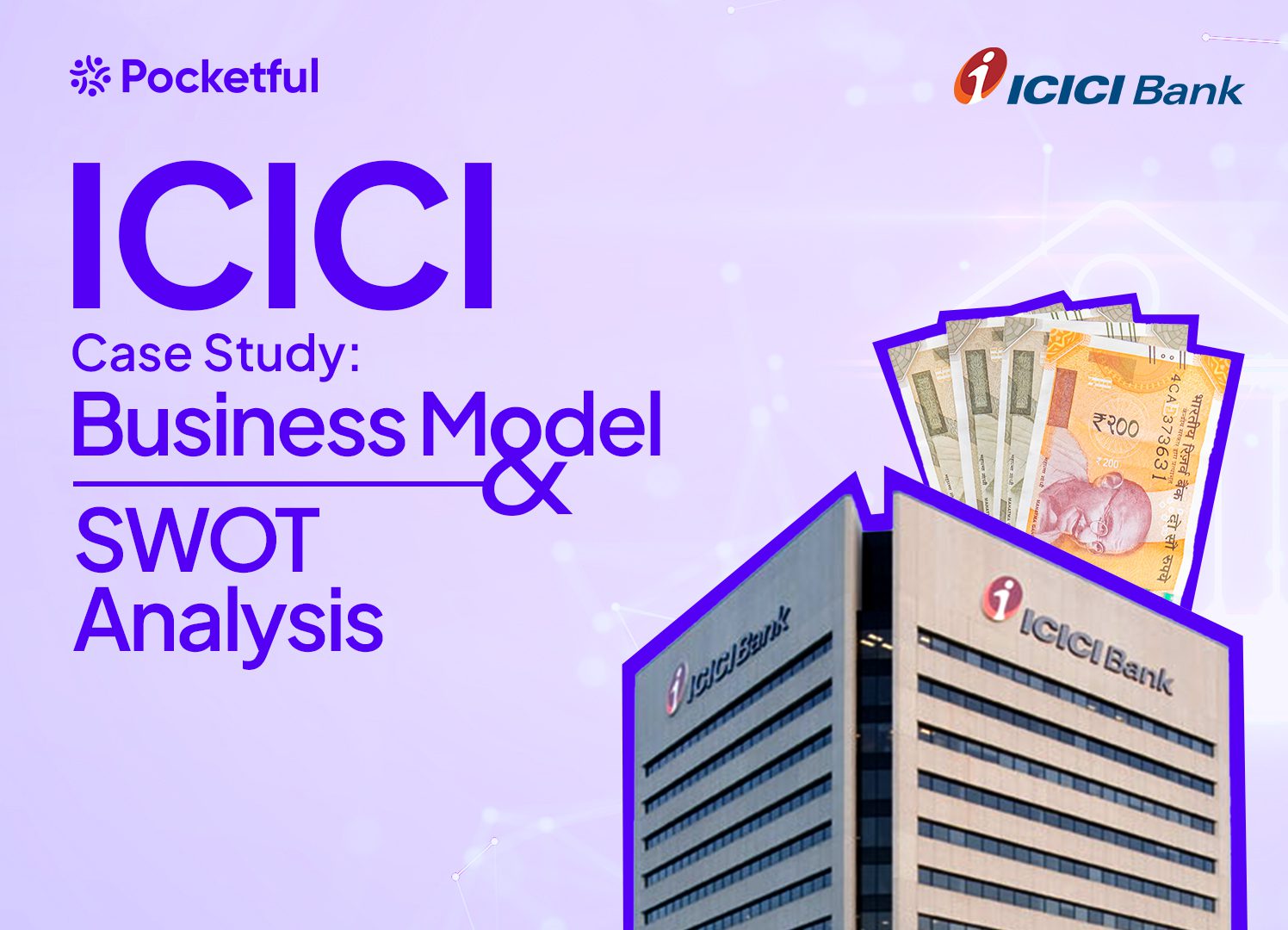| Type | Description | Contributor | Date |
|---|---|---|---|
| Post created | Pocketful Team | Mar-07-24 | |
| Add new links | Nisha | Feb-25-25 | |
| Add new links | Nisha | Feb-25-25 |

- Blog
- icici bank case study financials kpis growth strategies and swot analysis
ICICI Bank Case Study: Financials, KPIs, Growth Strategies, and SWOT Analysis

Financial Institutions are the backbone of the Indian economy as they accept funds from depositors and lend to those in need; this facilitates the flow of currency and thus helps the country move ahead.
Indian banks have played a crucial role in growing the GDP to 3.6 Trillion USD (As of Feb 24), making it essential to know about the situation of the banking industry. Therefore, in today’s blog, we’ll be talking about ICICI Bank, which constitutes almost 25% of the Bank Nifty Index (As of Feb 24).
ICICI Bank Overview
The Industrial Credit and Investment Corporation of India (ICICI) was a government entity established on the 5th of January 1994. Sir Arcot Ramasamy Mudaliar was elected as the first Chairman of ICICI Ltd. It is a multinational company and financial services company headquartered in Mumbai.
It offers several services in the sector of banking and finance for corporate entities and retail customers via a variety of delivery channels and specialized subsidiaries, including but not limited to investment banking, life insurance, non-life insurance, loans and venture capital.
| Full Name | Industrial Credit and Investment Corporation of India |
| Company Type | Listed |
| Industry | Finance and Banking services |
| Founded | 1994 |
| Headquarter | Mumbai, Maharashtra |
| Products offered | Consumer banking, Commercial banking, Insurance, Credit cards, Investment Banking, Mortgage loans, Private banking, Private equity, Investment Management, Asset management, Mutual funds, Wealth management, etc. |
| Subsidiaries | ICICI Prudential Life Insurance, ICICI Lombard, ICICI Securities, ICICI Direct, ICICI Home Finance Company |
| Presence | 5,900 Branches and 16,650 ATMs |
| Key people | Girish Chandra Chaturvedi (Chairman)Sandeep Bakhshi (MD & CEO) |

Key Highlights for FY2022-23:
● Total Deposits stood at ₹ 11,808 billion, and Total Advances were ₹ 10,196 billion.
● Net Interest Margin (NIM) is 4.48%, and Net Interest Income (NII) is ₹ 621 billion.
● Profit before tax, excluding treasury gains, reached ₹ 424.73 bn in FY2023.
● Core operating profit stood at ₹ 491.39 bn in FY2023.
● Provisions and contingencies were ₹ 424.73 bn in FY2023.
● Average current account deposits grew up 1.9% y-o-y to reach ₹ 1,614.86 billion.
● Average saving deposits grew up 5.5% y-o-y to reach ₹ 3,797.76 billion.
Key Data Points for ICICI
Let’s have a look at the statistical data of the company:
| Market Cap | ₹ 7,69,828 cr. |
| Current Price | ₹ 1,097 |
| Stock P/E | 18.2 |
| 52 Week High / Low | ₹ 1,114 / 810 |
| ROCE | 6.32 % |
| ROE | 17.2 % |
| Net Interest Margin (NIM) | 4.14% |
| CASA Ratio | 45.84% |
| Total Capital Adequacy Ratio | 18.34% |
Read Also: Axis Bank vs ICICI Bank: Analysis of Private Sector Banks
Strategy and Growth of ICICI Bank
Strategy
In 2023, Indian equities emerged as outperformers in the global space, particularly in the mid and large-cap space, while facing rising international policy rates, volatile community rates, and geopolitical tensions. During all this turbulence, ICICI stayed consistent and remained the 2nd largest private bank in India after HDFC Bank. Here are some of the strategies implemented by them.
● Credit Growth:
Loans are the primary revenue drivers for the bank and help to enhance the growth in the market. ICICI Bank has increased its domestic loan book by 20.5% y-o-y to reach ₹ 9855.28 bn. In FY23, the bank’s total advances grew by 18.7% y-o-y to reach ₹ 10,196.38 bn, and Overseas Book reached ₹ 341.1 bn.

● Deposit Growth:
In FY23, deposits increased by 11% y-o-y to reach ₹ 11,808.41 bn. Overall, the average CASA deposit growth was 13.3%.
● Capital Adequacy:
Capital Adequacy stood at 18.34% for FY23, 19.16% for FY22 and 19.12% for FY21. Thus indicating a healthy margin over the RBI-mandated percentage.
● Profit After Tax (PAT):
Profit after tax increased to ₹ 318.96 bn, growing at 36.7%.
Did you know?
ICICI Bank has supported over 400 hospitals, benefitting over 1.5 million people by fostering healthcare facilities and infrastructure.

SWOT Analysis of ICICI Bank
Strengths
● ICICI Bank has a presence in 19 countries. Thus making it easier for it to expand further.
● In FY23, ICICI had a nationwide network of 5,900 branches and 16,650 ATMs.
● ICICI boasts about a robust infrastructure with a meagre crash rate. ICICI hosts 1.5 million active users on its banking app InstaBIZ, the value of which grew 22% in FY23.
● This bank enjoys a strong brand identity due to its vast branches and ATM network.
Weaknesses
● ICICI Bank faces tough competition from SBI and HDFC bank, making it difficult for ICICI to improve its ranking beyond the current position of 3rd largest bank in India (in terms of deposits).
● The banking industry, in general, saw massive corrections in FY23 as the bull run of 2021-2022 seems to be coming to an end. This can be noticed by comparing Nifty Bank returns with other indices; Nifty Bank grew around 15% while Nifty Pharma grew at 63% (in FY23).
Opportunities
● While it may seem difficult for ICICI to outgrow SBI and HDFC, it is still possible via implementing fast growth strategies such as expansion in tier 3, M&A, etc.
● ICICI’s penetration into the Tier 3 segment of India remains limited; they can gain considerable market share if they focus on substantially improving customer service in Tier 3.
Threats
● Policies impact the banking industry significantly, any unanticipated changes in the monetary policy can cause substantial damage to the bank’s KPIs.
● The bank has grown considerably in the last decade, this was made possible due to the brilliant policies and strategies of the management. But, the banking industry is extremely volatile and failure to adapt quickly could erode all the success.
● NBFCs and Fintechs have seen a massive uptrend in the past few years. This trend will likely continue and potentially revolutionize the banking industry as we know it. This could substantially affect the business’s bottom line figures.
Read Also: Yes Bank Case Study: Business Model, Financial Statement, SWOT Analysis
Conclusion
In summation, we evaluated the business, growth strategy, and financials of ICICI Bank. As of February 2024, It is the 2nd largest bank in the nation in terms of Market capitalization and represents a strong position to capture market share amidst the growing demand for credit in the upcoming years.
Frequently Asked Questions (FAQs)
Is ICICI the largest bank in India?
ICICI Bank is the 2nd largest bank in India in terms of Market Capitalization.
Who is the CEO of ICICI Bank?
Sandeep Bakhshi heads ICICI Bank as the MD and CEO.
What is ICICI Bank known for?
ICICI Bank offers corporate and retail customers a wide range of banking products and financial services through various delivery channels and its group companies.
Is ICICI Bank a Private Bank or a Government Bank?
ICICI Bank is a Private sector bank.
What is the full form of ICICI?
The ICICI stands for Industrial Credit and Investment Corporation of India.
Disclaimer
The securities, funds, and strategies discussed in this blog are provided for informational purposes only. They do not represent endorsements or recommendations. Investors should conduct their own research and seek professional advice before making any investment decisions.